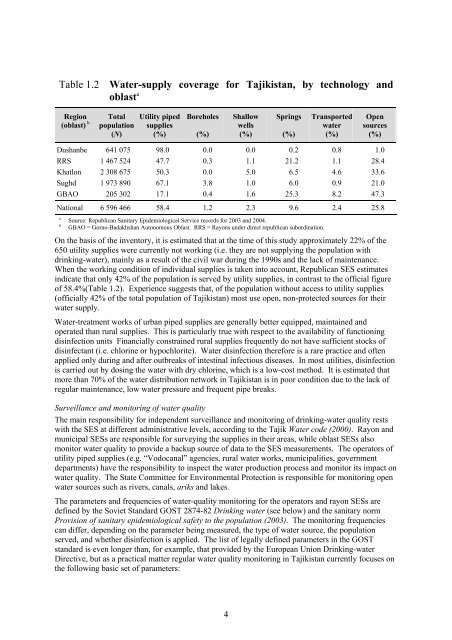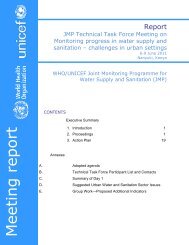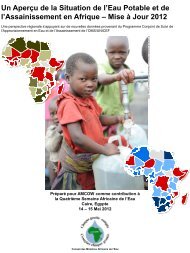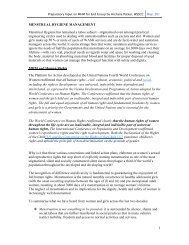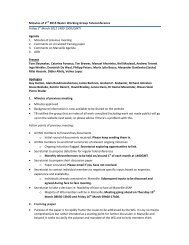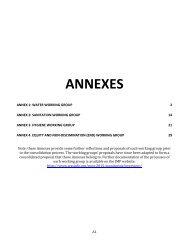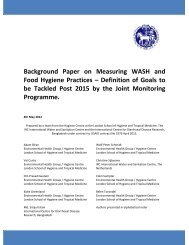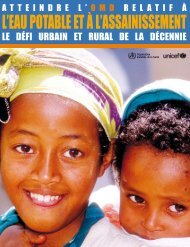rapid assessment of drinking-water quality in the republic of tajikistan
rapid assessment of drinking-water quality in the republic of tajikistan
rapid assessment of drinking-water quality in the republic of tajikistan
You also want an ePaper? Increase the reach of your titles
YUMPU automatically turns print PDFs into web optimized ePapers that Google loves.
Table 1.2 Water-supply coverage for Tajikistan, by technology and<br />
oblast a<br />
Region<br />
(oblast) b<br />
Total<br />
population<br />
(N)<br />
Utility piped<br />
supplies<br />
(%)<br />
Boreholes<br />
(%)<br />
Shallow<br />
wells<br />
(%)<br />
Spr<strong>in</strong>gs<br />
(%)<br />
Transported<br />
<strong>water</strong><br />
(%)<br />
Open<br />
sources<br />
(%)<br />
Dushanbe 641 075 98.0 0.0 0.0 0.2 0.8 1.0<br />
RRS 1 467 524 47.7 0.3 1.1 21.2 1.1 28.4<br />
Khatlon 2 308 675 50.3 0.0 5.0 6.5 4.6 33.6<br />
Sughd 1 973 890 67.1 3.8 1.0 6.0 0.9 21.0<br />
GBAO 205 302 17.1 0.4 1.6 25.3 8.2 47.3<br />
National 6 596 466 58.4 1.2 2.3 9.6 2.4 25.8<br />
a<br />
b<br />
Source: Republican Sanitary Epidemiological Service records for 2003 and 2004.<br />
GBAO = Gorno-Badakhshan Autonomous Oblast. RRS = Rayons under direct <strong>republic</strong>an subord<strong>in</strong>ation.<br />
On <strong>the</strong> basis <strong>of</strong> <strong>the</strong> <strong>in</strong>ventory, it is estimated that at <strong>the</strong> time <strong>of</strong> this study approximately 22% <strong>of</strong> <strong>the</strong><br />
650 utility supplies were currently not work<strong>in</strong>g (i.e. <strong>the</strong>y are not supply<strong>in</strong>g <strong>the</strong> population with<br />
<strong>dr<strong>in</strong>k<strong>in</strong>g</strong>-<strong>water</strong>), ma<strong>in</strong>ly as a result <strong>of</strong> <strong>the</strong> civil war dur<strong>in</strong>g <strong>the</strong> 1990s and <strong>the</strong> lack <strong>of</strong> ma<strong>in</strong>tenance.<br />
When <strong>the</strong> work<strong>in</strong>g condition <strong>of</strong> <strong>in</strong>dividual supplies is taken <strong>in</strong>to account, Republican SES estimates<br />
<strong>in</strong>dicate that only 42% <strong>of</strong> <strong>the</strong> population is served by utility supplies, <strong>in</strong> contrast to <strong>the</strong> <strong>of</strong>ficial figure<br />
<strong>of</strong> 58.4%(Table 1.2). Experience suggests that, <strong>of</strong> <strong>the</strong> population without access to utility supplies<br />
(<strong>of</strong>ficially 42% <strong>of</strong> <strong>the</strong> total population <strong>of</strong> Tajikistan) most use open, non-protected sources for <strong>the</strong>ir<br />
<strong>water</strong> supply.<br />
Water-treatment works <strong>of</strong> urban piped supplies are generally better equipped, ma<strong>in</strong>ta<strong>in</strong>ed and<br />
operated than rural supplies. This is particularly true with respect to <strong>the</strong> availability <strong>of</strong> function<strong>in</strong>g<br />
dis<strong>in</strong>fection units F<strong>in</strong>ancially constra<strong>in</strong>ed rural supplies frequently do not have sufficient stocks <strong>of</strong><br />
dis<strong>in</strong>fectant (i.e. chlor<strong>in</strong>e or hypochlorite). Water dis<strong>in</strong>fection <strong>the</strong>refore is a rare practice and <strong>of</strong>ten<br />
applied only dur<strong>in</strong>g and after outbreaks <strong>of</strong> <strong>in</strong>test<strong>in</strong>al <strong>in</strong>fectious diseases. In most utilities, dis<strong>in</strong>fection<br />
is carried out by dos<strong>in</strong>g <strong>the</strong> <strong>water</strong> with dry chlor<strong>in</strong>e, which is a low-cost method. It is estimated that<br />
more than 70% <strong>of</strong> <strong>the</strong> <strong>water</strong> distribution network <strong>in</strong> Tajikistan is <strong>in</strong> poor condition due to <strong>the</strong> lack <strong>of</strong><br />
regular ma<strong>in</strong>tenance, low <strong>water</strong> pressure and frequent pipe breaks.<br />
Surveillance and monitor<strong>in</strong>g <strong>of</strong> <strong>water</strong> <strong>quality</strong><br />
The ma<strong>in</strong> responsibility for <strong>in</strong>dependent surveillance and monitor<strong>in</strong>g <strong>of</strong> <strong>dr<strong>in</strong>k<strong>in</strong>g</strong>-<strong>water</strong> <strong>quality</strong> rests<br />
with <strong>the</strong> SES at different adm<strong>in</strong>istrative levels, accord<strong>in</strong>g to <strong>the</strong> Tajik Water code (2000). Rayon and<br />
municipal SESs are responsible for survey<strong>in</strong>g <strong>the</strong> supplies <strong>in</strong> <strong>the</strong>ir areas, while oblast SESs also<br />
monitor <strong>water</strong> <strong>quality</strong> to provide a backup source <strong>of</strong> data to <strong>the</strong> SES measurements. The operators <strong>of</strong><br />
utility piped supplies (e.g. “Vodocanal” agencies, rural <strong>water</strong> works, municipalities, government<br />
departments) have <strong>the</strong> responsibility to <strong>in</strong>spect <strong>the</strong> <strong>water</strong> production process and monitor its impact on<br />
<strong>water</strong> <strong>quality</strong>. The State Committee for Environmental Protection is responsible for monitor<strong>in</strong>g open<br />
<strong>water</strong> sources such as rivers, canals, ariks and lakes.<br />
The parameters and frequencies <strong>of</strong> <strong>water</strong>-<strong>quality</strong> monitor<strong>in</strong>g for <strong>the</strong> operators and rayon SESs are<br />
def<strong>in</strong>ed by <strong>the</strong> Soviet Standard GOST 2874-82 Dr<strong>in</strong>k<strong>in</strong>g <strong>water</strong> (see below) and <strong>the</strong> sanitary norm<br />
Provision <strong>of</strong> sanitary epidemiological safety to <strong>the</strong> population (2003). The monitor<strong>in</strong>g frequencies<br />
can differ, depend<strong>in</strong>g on <strong>the</strong> parameter be<strong>in</strong>g measured, <strong>the</strong> type <strong>of</strong> <strong>water</strong> source, <strong>the</strong> population<br />
served, and whe<strong>the</strong>r dis<strong>in</strong>fection is applied. The list <strong>of</strong> legally def<strong>in</strong>ed parameters <strong>in</strong> <strong>the</strong> GOST<br />
standard is even longer than, for example, that provided by <strong>the</strong> European Union Dr<strong>in</strong>k<strong>in</strong>g-<strong>water</strong><br />
Directive, but as a practical matter regular <strong>water</strong> <strong>quality</strong> monitor<strong>in</strong>g <strong>in</strong> Tajikistan currently focuses on<br />
<strong>the</strong> follow<strong>in</strong>g basic set <strong>of</strong> parameters:<br />
4


